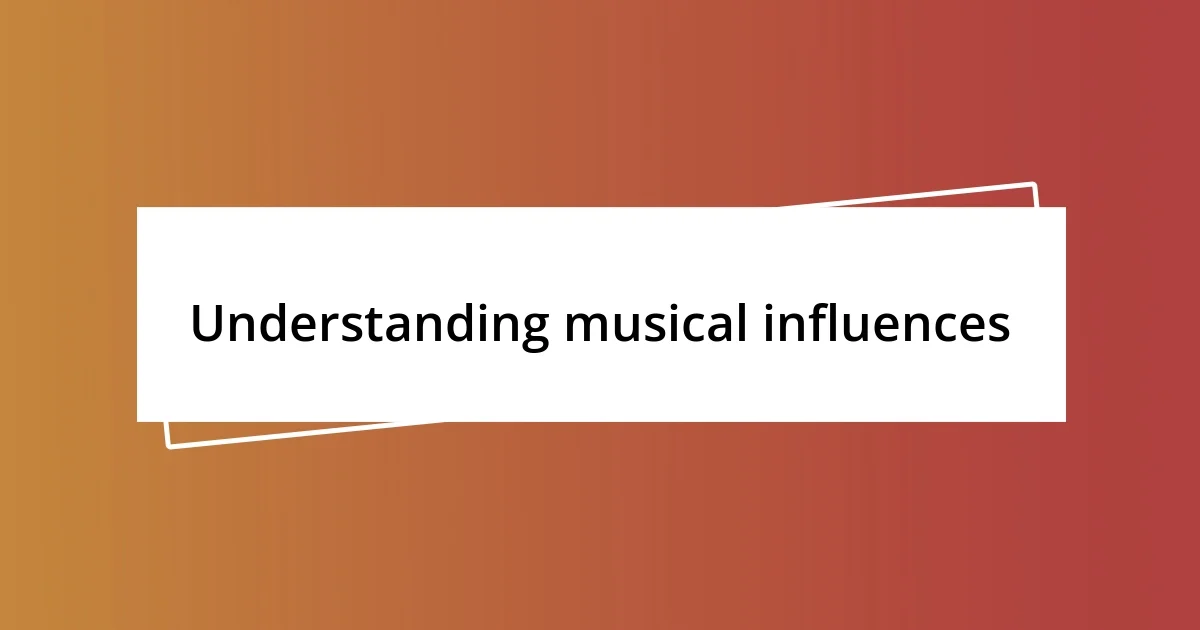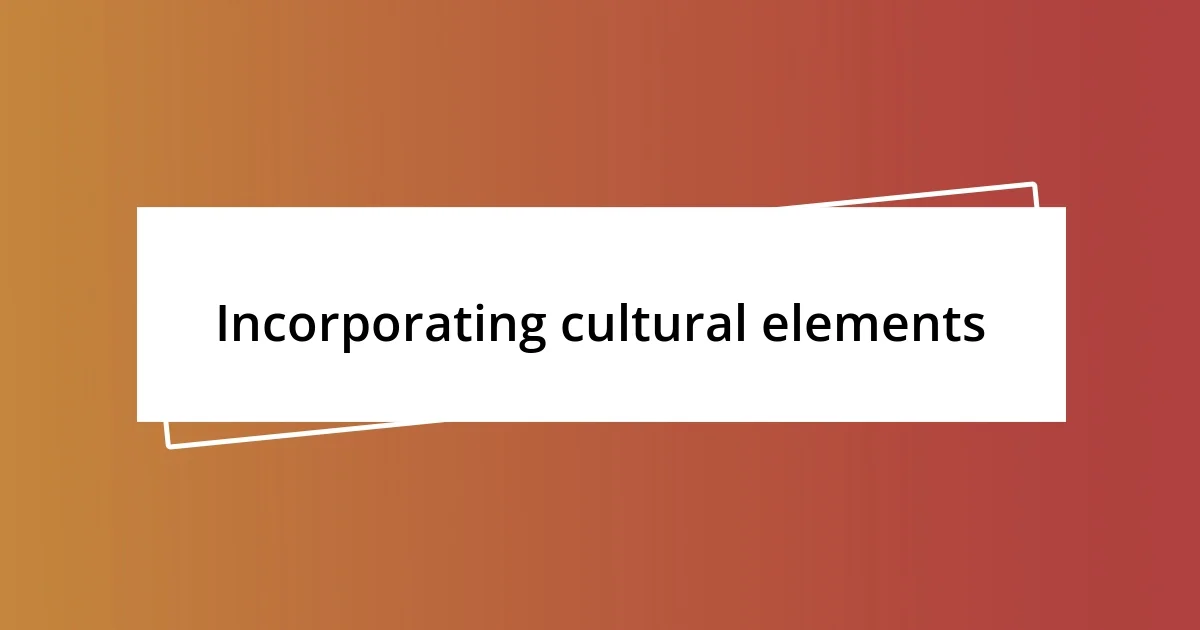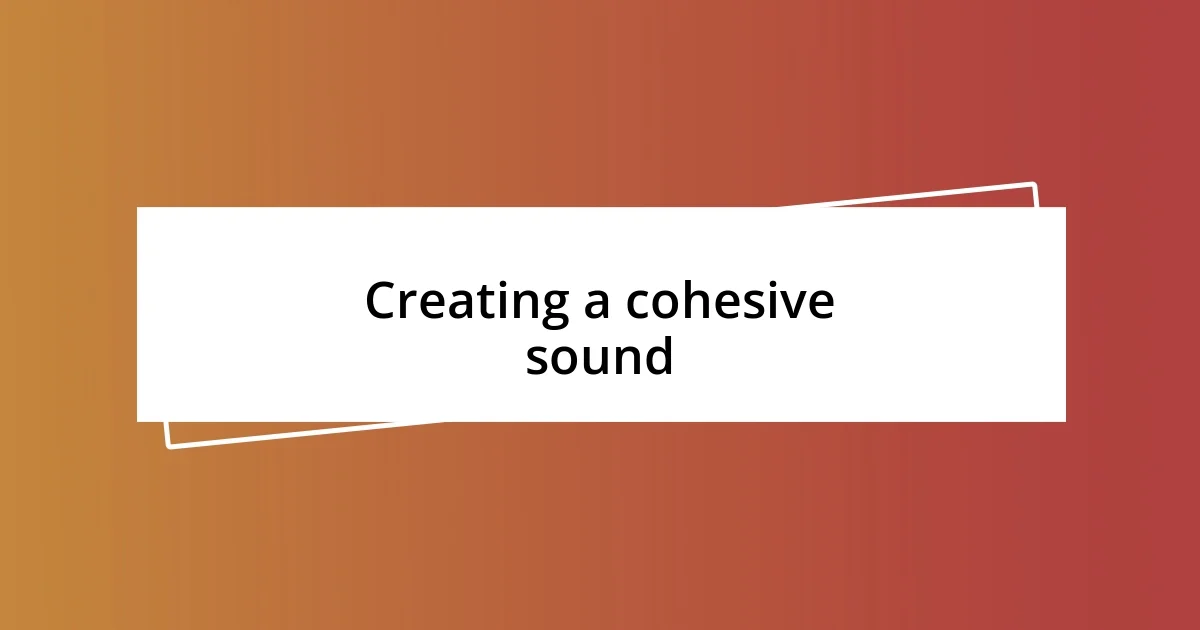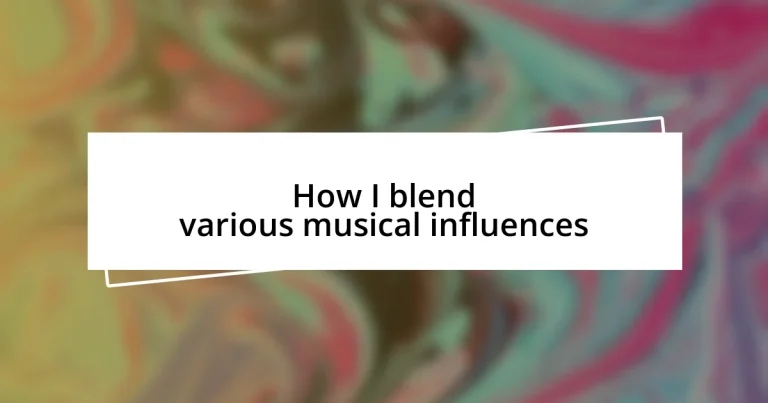Key takeaways:
- Musical influences shape artists’ identities and exploring different genres enhances creativity and emotional connection.
- Incorporating cultural elements and experimenting with instrumentation can lead to unexpected and enriching musical experiences.
- Creating a cohesive sound requires thoughtful blending of styles, paying attention to mood, tone, and effective transitions to unify diverse influences.

Understanding musical influences
Musical influences are like fingerprints; they uniquely shape who we are as artists or listeners. I remember the first time I heard a blues track that left me breathless. The raw emotion in the singer’s voice resonated deeply with me, sparking my curiosity about how different genres reflect the human experience. Have you ever felt a particular song transport you to a different place in your life? That’s the beauty of music’s influence.
Early on in my musical journey, I discovered how elements from various styles could intertwine to create something totally fresh. For example, blending jazz improvisation with pop melodies not only expanded my skill set but also allowed me to express my emotions in ways I hadn’t mastered before. It’s fascinating how each note carries the weight of the influences behind it, don’t you think?
Furthermore, understanding musical influences is not just about the sounds we hear; it’s about the stories behind them. Every genre, from classical to hip-hop, has roots in diverse cultures and histories that offer rich narratives. I often find myself diving into the origins of my favorite tracks, uncovering the experiences and struggles of the artists. It makes me appreciate the music on an entirely different level and inspires me to infuse those diverse elements into my own style. How do you connect with the stories in the music you love?

Exploring different genres
Exploring different genres can be an exhilarating journey. I recall sitting in a cozy coffee shop, listening to a mesmerizing fusion of world music and electronic beats. The way rhythms from various cultures intertwined made me realize just how much I could draw from different musical heritages. It was a moment that ignited my passion for experimenting with genre blends, pushing me to explore everything from reggae’s laid-back vibes to the intensity of heavy metal.
- I’ve found that blending genres allows for limitless creativity.
- Each genre has its own unique emotional landscape, painting diverse stories through sound.
- Exploring a mix not only broadens my musical palette but also opens up new ways to connect with listeners, as they can resonate with different influences.
- The challenge often becomes finding harmony between dissimilar styles, which can lead to unexpected surprises that keep both me and my audience engaged.
I often think about how classical music’s intricate arrangements can breathe life into a simple pop ballad. The first time I layered a symphonic melody over a catchy hook, it felt like I was unlocking a door to a new artistic realm. This blending process deepens my understanding of how musical elements work together, creating a richer tapestry of sound that speaks to the heart.

Identifying personal musical roots
Identifying our personal musical roots is an essential step in understanding how we express ourselves through sound. For me, this journey began during lazy summer afternoons spent listening to my dad’s old vinyl records. The warmth of the guitar riffs in classic rock and the intricate melodies of folk music formed the backdrop of my childhood. I often think about how these experiences shaped my preferences, laying the groundwork for my own musical style.
As I delved deeper into my musical identity, I realized that specific artists profoundly influenced my taste. The heart-wrenching ballads of singer-songwriters remind me of late-night conversations with friends, where emotions ran deep under the stars. Each note feels like a shared memory, bridging past and present. This connection not only illuminates my roots but also enhances my ability to create music that feels authentic and relatable.
The discovery of my musical heritage has been a revealing process, reminiscent of piecing together a puzzle. I vividly remember attending my first live jazz performance, where I felt the rhythmic interplay of instruments resonate within me. It sparked a fascination with improvisation that now influences my creative efforts. By recognizing and embracing these personal roots, I enrich my musical expression, inviting others to experience the diverse influences that shape who I am today.
| Musical Element | Experience |
|---|---|
| Classic Rock | Dad’s vinyl records filled my childhood with warmth and inspiration. |
| Singer-Songwriters | Late-night conversations amplified my connection to heartfelt lyrics. |
| Jazz | First live performance opened my eyes to the beauty of improvisation. |

Techniques for blending styles
Finding effective techniques for blending musical styles involves a delicate balance of creativity and structure. One of my favorite methods is experimenting with tempo changes. I often take a classic ballad and speed it up, infusing it with a fresh, energetic vibe. It’s fascinating to see how even a small shift in speed can transform the emotional impact of a piece. How do you think listeners would react to something familiar but with an unexpected twist?
Another technique I enjoy is layering different instrumental textures. Recently, while arranging a piece, I juxtaposed a traditional sitar melody with electronic synths. The combination created a beautiful tension that kept my imagination flowing. This reminded me that contrasting elements can coexist harmoniously, leading to a richer sound. It’s all about finding those magical moments where genres can interlace seamlessly.
Finally, I love the idea of incorporating call-and-response motifs that often appear in various folk traditions. During a jam session, I initiated a playful back-and-forth between a heavy metal guitar riff and a soft acoustic strum. The process not only ignited excitement among the players but also invited the audience to engage with the performance. What if we all approached our music this way, allowing our creative inputs to spark fresh dialogues? Blending styles becomes a conversation, an exchange of sounds that echo our diverse musical journeys.

Incorporating cultural elements
Incorporating cultural elements into my music feels like unfolding a map of experiences that enrich my sound. I remember a trip to Morocco, where the vibrant rhythms of street musicians captivated my heart. Their infectious beats made me realize the power of percussion in storytelling. Since then, I’ve tried to weave intricate hand percussion into my songs, creating a sound tapestry that pays homage to those lively moments.
I find myself constantly inspired by the diverse musical traditions I encounter. For instance, during a workshop on Afro-Cuban music, I was introduced to the clave rhythm, a foundational element that shifted my understanding of groove. I experimented by layering these rhythms over my acoustic pieces, adding depth and excitement. It’s thrilling to see how a simple cultural element can instantly breathe new life into my compositions. Have you ever thought about how rhythmic variations can transform a familiar melody into something extraordinary?
Embracing these cultural influences involves more than just mimicking styles; it’s about finding a genuine connection. When I collaborated with musicians from India, I felt a profound sense of unity as we combined raag scales with Western harmonies. This blending created an emotional depth that resonated with both our backgrounds. I can’t help but wonder: What if every musician explored elements from different cultures? The possibilities would be endless, inviting a rich dialogue through sound that transcends boundaries.

Experimenting with instrumentation
Experimenting with instrumentation has brought me some of my most electrifying musical moments. A while back, I found myself in the studio surrounded by an array of instruments — a ukulele, a mandolin, and even an old accordion. As I began layering sounds, it hit me how a light strumming on the ukulele could juxtapose beautifully with the airy tones of the accordion, creating a whimsical backdrop. Have you ever stumbled upon a unique combination that surprised you?
There are days when I delight in exploring unconventional instruments, such as using a kalimba alongside a rock drum kit. The warm, plucky notes of the kalimba added a new dimension to the hard-hitting beats, revealing softer nuances in the arrangement. This experimentation has often led to moments of sheer joy and unexpected creativity, prompting me to ask: What happens when we step outside our comfort zones and embrace the unknown?
One memorable session found me blending the rich sounds of a classical cello with synthesized beats. The cello brought a profound emotional weight while the synths provided a modern edge. It was exhilarating to watch my bandmates’ reactions as each instrument conversed with the other, encouraging spontaneous improvisation. Isn’t it fascinating how the right combination of instrumentation can elicit a whole new range of emotions? This blend taught me that sometimes the most poignant moments in music come from the unlikeliest pairings.

Creating a cohesive sound
Creating a cohesive sound is often about finding harmony among different elements, and I’ve discovered that it takes thoughtful experimentation. I recall a time when I fused elements of blues with folk melodies while writing a new song. That moment when the bluesy guitar riff perfectly complemented the lilting folk lyrics was exhilarating; it felt as if the music was telling a story that only it could convey. Have you ever experienced that magical moment when two seemingly different styles just click into place?
I’ve learned that consistency in mood and tone is crucial for blending various influences effectively. For instance, during a collaboration with a jazz drummer, we focused on creating a track that maintained a steady groove while allowing for improvisation. Choosing chords and melodies that echoed each other’s emotional undertones made all the difference. This led me to wonder: How often do we overlook the importance of emotional threads that tie disparate sounds together?
Moreover, creating a cohesive sound involves being mindful of transitions. I remember incorporating a classical transition between verses in one of my tracks, bridging the gap between the modern and the traditional. The seamless flow not only surprised listeners but also drew them deeper into the journey of the song. Isn’t it interesting how a well-crafted transition can make such a significant impact, allowing the various influences to coexist beautifully?














